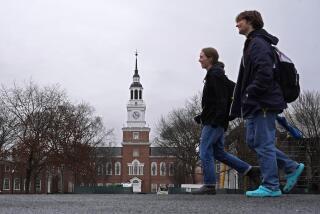New Tax Laws Make Saving for College More Difficult
- Share via
NEW YORK — The new federal tax laws make saving for college tougher, according to a parents’ guide published recently by the College Board.
The $12.95 paperback, “How to Pay for Your Children’s College,” was written for parents who expect to pay most of the college bill down the road for children who are now preteens.
Gerald Krefetz, the author and an investment expert, cautions:
“The 1986 Tax Reform Act has altered or abolished virtually all the techniques for saving on taxes that parents have used in the past to help pay for their children’s college education.
Escalating Costs
“The Tax Reform Act and Higher Education Amendments (raising the limits on some of the major student loan programs) make it likely that students and their families will emerge from a two- or four-year college education deeper in debt than ever before.”
He contends that the situation is further complicated by escalating college costs and significantly declining financial aid funds.
“What is clear is that as the government tightens its purse strings to deal with massive deficits, families will have to shoulder more and more of the expense of a college education,” he reports.
“The bottom line is that they will have to generate more money than ever before to cover college costs.
“The key factor is setting realistic goals and fulfilling them.
“Only long-term planning can significantly ease the burden of paying college costs and enable parents and students to avoid the drain on future income resulting from loan repayments.”
In the book, Krefetz describes specific strategies needed to save and build college funds. He examines pros and cons of each. The turf includes passbook savings accounts, zero-coupon bonds and income-shifting techniques, as well as using fringe benefits for educational purposes.
Loans Reviewed
He also reviews use of loans and describes ways to borrow economically from private as well as governmental loan programs.
Also discussed are tuition futures and other long-range planning tactics.
Some other points about the tax laws:
- The act eliminates some incentives and motivations to save for an education. “It has removed not only some basic tax advantages for colleges and universities but has made it more difficult (more costly) for students to earn, borrow and pay for school.”
- “Almost every aspect of traditional college financing has been touched in some fashion by the new tax code.”
College costs increased an average of 7% at public colleges and universities during the 1986-87 academic year, according to the National Institute of Education, a part of the U.S. Department of Education.
Public colleges are the lowest-cost ones for consumers. That is because the expenses are subsidized by state or municipal tax funds.
The College Board estimates that the current average annual costs at 4-year public colleges are about $5,789 for students who live on campus and $4,554 for those who live at home.
Averages for four-year private colleges are $11,982 for resident students and $10,173 for commuters.
Average total cost for the 10 most expensive private colleges is around $17,000 this year; for the 10 most expensive public colleges, more than $7,000.
“The reasons for the escalation in educational costs are numerous, but perhaps the primary one is an attempt by colleges to reverse the tremendous losses in faculty purchasing power over the last decade or so.
Burdened by Costs
“When salaries are adjusted for inflation, college teachers make approximately 20% less than they did in 1971. In addition, colleges are burdened with the ongoing costs of expansion that occurred in the ‘60s and ‘70s to meet the baby boomers’ requirements.
“Moreover, schools had to be retrofitted with computers and other devices to catch up with the information explosion and scientific revolution of the last decade.”
Chances of college costs going down are remote, according to Krefetz.
“Not one economist in a hundred foresees a deflation in educational expenses in the next five years. If costs continue at the same rate, by 1992, tuition is likely to double,” he said.
“One investment banking house has estimated that if the average cost for a private college was (in 1986-87) $10,200, a 6% inflation rate will put that figure at $25,000 in the year 2000.”
More to Read
Sign up for Essential California
The most important California stories and recommendations in your inbox every morning.
You may occasionally receive promotional content from the Los Angeles Times.













